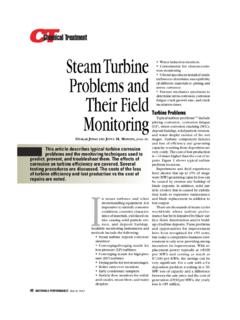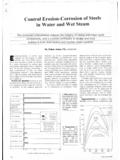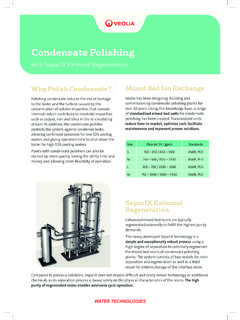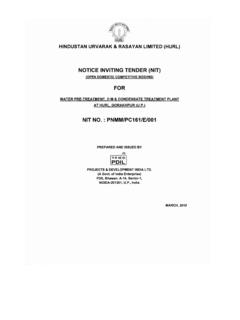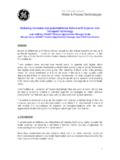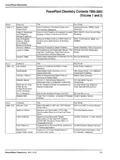Transcription of CYCLE CHEMISTRY COMMISSIONING - Jonas Inc
1 CYCLE CHEMISTRY COMMISSIONING Otakar Jonas , , Lee Machemer, Jonas , Inc. 1113 Faun Road Wilmington, DE 19803 USA Abstract This paper presents an outline of CYCLE CHEMISTRY COMMISSIONING guidelines and a brief description of selected case histories where delays of commercial operation and equipment damage resulted from insufficient water CHEMISTRY -related COMMISSIONING . Operation delays have resulted in cost penalties of millions of dollars (at ~$300,000/day) and the equipment damage has been as high as $100 million in one unit.
2 The ultimate root cause of the above problems is poor system management by OEMs, architect engineers, operators, and CHEMISTRY consultants. The technical root causes, all of them predictable and correctable, include bad design and material selection, water treatment system operation and chemicals, instrumentation and chemical control not ready, corrosion during equipment storage, high boiler carry-over, and lack of operator and chemist training. Introduction COMMISSIONING delays and equipment damage as a result of inadequate COMMISSIONING have been a major problem for over 50% (estimate) of new units of all types and for older units after upgrades and operation and CHEMISTRY changes.
3 Today, most of these problems can be avoided because there is sufficient knowledge in the areas of water CHEMISTRY and corrosion [1 to 29] and ample experience. It is mostly a problem of the transfer and use of the knowledge and of management. During COMMISSIONING , the risk of water CHEMISTRY -related delays is high, while at the same time, the analysis and control of CYCLE CHEMISTRY is typically at its lowest level in the life of the unit. Many problems can be avoided if the proper steps are taken throughout the design, construction and COMMISSIONING of the unit.
4 These delays are a result of the lack of readiness of the CYCLE CHEMISTRY -related equipment, accumulation of corrosion products, the use of the wrong water treatment chemicals, and a general neglect of CYCLE CHEMISTRY and corrosion. A solution to reduce the frequency of CYCLE CHEMISTRY -related delays is to implement CYCLE CHEMISTRY COMMISSIONING Guidelines for all new plants, major equipment upgrades, and after operation (load increase, base load to cycling, etc.) and water CHEMISTRY changes. This paper outlines such a document and presents case histories where the use of these Guidelines could have prevented problems and saved millions of dollars.
5 COMMISSIONING Guidelines The CYCLE CHEMISTRY COMMISSIONING Guidelines are a combination of action items and checklists for verifying that all CYCLE CHEMISTRY -related equipment is operational and in good condition, personnel are properly trained, and procedures are in place for sampling, analysis and control of CYCLE CHEMISTRY parameters. In order to be the most effective, the Guidelines must be customized for each plant based on CYCLE design and type of operation. The purpose of the Guidelines is to prevent delays in the COMMISSIONING activities and prevent short- and long-term CYCLE CHEMISTRY and corrosion problems.
6 To achieve this, the Guidelines contain all of the steps which must be taken to ensure the entire CYCLE is as clean as possible so that the CYCLE CHEMISTRY can quickly be brought within recommended limits. They also make sure that the water and steam sampling and analysis systems are prepared to obtain and analyze water and steam samples at the first fire. The Guidelines are most effective when they include the CYCLE design review, material selection, and water CHEMISTRY control (water treatment and monitoring) verification. This requires the cooperation of OEMs, architect engineers, owners, and operators.
7 The following are the topics which should be covered in the COMMISSIONING Guidelines: Review of CYCLE and component design ( CHEMISTRY vs. corrosion, impurity transport, flow-accelerated corrosion, heat flux, stresses, etc.) [1 to 8] Water CHEMISTRY control and management guidelines - plant specific [9 to 20] Equipment preservation during manufacture, transport, storage, erection, and layup and the subsequent removal of preservatives Training of operators and chemists before the start of COMMISSIONING Manuals Inspections of CYCLE CHEMISTRY -related equipment Maintenance procedures Pre-operational cleaning (acid, steam/air blow) and hydrotesting [26 to 28] Pre-steaming checks - boiler, turbine, condensate polishing, condenser, etc.
8 Performance testing - steam purity/carry-over, boiler hideout, iron transport, etc. [2, 9 to 23] Sampling system design and operation [21 to 23] Cooling water system Chemical discharges/disposal Chemical laboratory Safety issues [8] COMMISSIONING schedule Each topic should have its own action items and a checklist of tasks to be signed off at different times during the plant design, construction and COMMISSIONING processes. Individual items in the checklist should be assigned to the contractor and owner representatives, and the timing of the checks should be coordinated with the erection and COMMISSIONING schedule.
9 In order to be an effective document, management must be involved in its application and require that all pertinent items be signed off before proceeding. These Guidelines would not be a substitute for other COMMISSIONING and operation documents. Design Review - The purpose of the steam CYCLE design review [2 to 8] is to theoretically establish CYCLE chemical transport characteristics such as sources, transport, and removal of corrosion products, deaeration characteristics, effects of condenser leaks and air inleakage, and decomposition and transport of organics.
10 The review of component design should focus on concentration of impurities on component surfaces ( , boiler tubes and turbines), and on the effects of heat transfer and stress on corrosion, stress corrosion, and corrosion fatigue. Performance Testing - should include experimental determination of the CYCLE chemical transport characteristics, in particular boiler carry-over and steam purity, boiler hideout, deaeration, makeup and polisher performance, and iron transport. It may require intensive two-week monitoring of water and steam CHEMISTRY under anticipated operating conditions.
